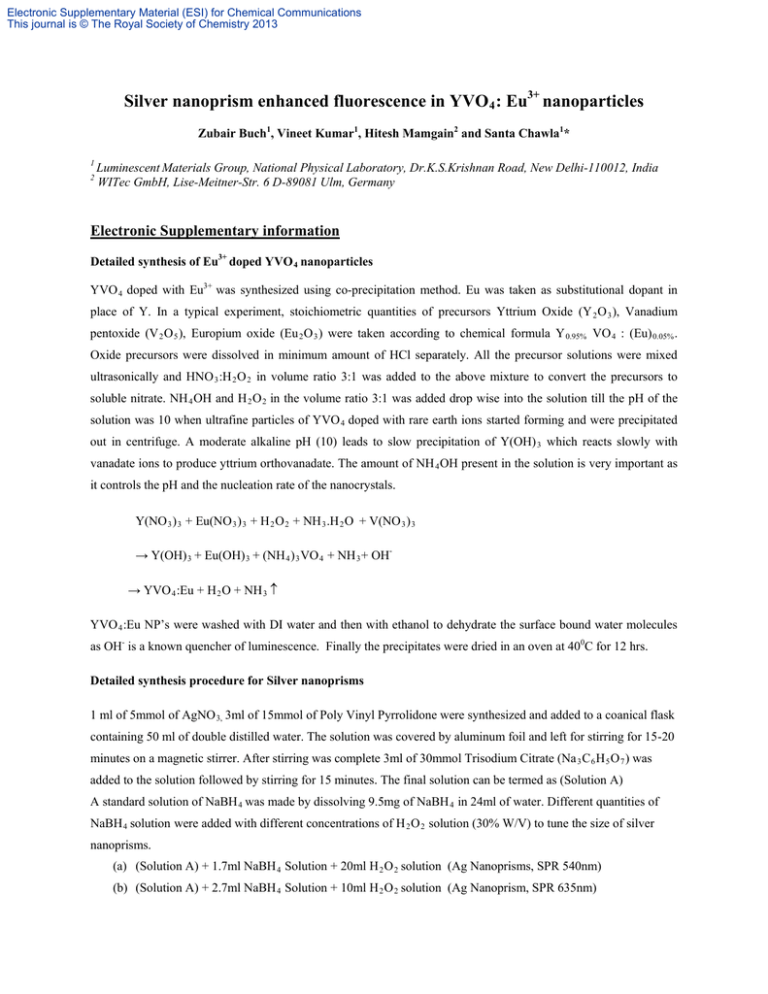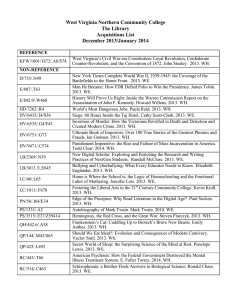Silver nanoprism enhanced fluorescence in YVO4: Eu3+ nanoparticles
advertisement

Electronic Supplementary Material (ESI) for Chemical Communications This journal is © The Royal Society of Chemistry 2013 Silver nanoprism enhanced fluorescence in YVO 4 : Eu3+ nanoparticles Zubair Buch1, Vineet Kumar1, Hitesh Mamgain2 and Santa Chawla1* 1 2 Luminescent Materials Group, National Physical Laboratory, Dr.K.S.Krishnan Road, New Delhi-110012, India WITec GmbH, Lise-Meitner-Str. 6 D-89081 Ulm, Germany Electronic Supplementary information Detailed synthesis of Eu3+ doped YVO 4 nanoparticles YVO 4 doped with Eu3+ was synthesized using co-precipitation method. Eu was taken as substitutional dopant in place of Y. In a typical experiment, stoichiometric quantities of precursors Yttrium Oxide (Y 2 O 3 ), Vanadium pentoxide (V 2 O 5 ), Europium oxide (Eu 2 O 3 ) were taken according to chemical formula Y 0.95% VO 4 : (Eu) 0.05% . Oxide precursors were dissolved in minimum amount of HCl separately. All the precursor solutions were mixed ultrasonically and HNO 3 :H 2 O 2 in volume ratio 3:1 was added to the above mixture to convert the precursors to soluble nitrate. NH 4 OH and H 2 O 2 in the volume ratio 3:1 was added drop wise into the solution till the pH of the solution was 10 when ultrafine particles of YVO 4 doped with rare earth ions started forming and were precipitated out in centrifuge. A moderate alkaline pH (10) leads to slow precipitation of Y(OH) 3 which reacts slowly with vanadate ions to produce yttrium orthovanadate. The amount of NH 4 OH present in the solution is very important as it controls the pH and the nucleation rate of the nanocrystals. Y(NO 3 ) 3 + Eu(NO 3 ) 3 + H 2 O 2 + NH 3 .H 2 O + V(NO 3 ) 3 → Y(OH) 3 + Eu(OH) 3 + (NH 4 ) 3 VO 4 + NH 3 + OH→ YVO 4 :Eu + H 2 O + NH 3 ↑ YVO 4 :Eu NP’s were washed with DI water and then with ethanol to dehydrate the surface bound water molecules as OH- is a known quencher of luminescence. Finally the precipitates were dried in an oven at 400C for 12 hrs. Detailed synthesis procedure for Silver nanoprisms 1 ml of 5mmol of AgNO 3, 3ml of 15mmol of Poly Vinyl Pyrrolidone were synthesized and added to a coanical flask containing 50 ml of double distilled water. The solution was covered by aluminum foil and left for stirring for 15-20 minutes on a magnetic stirrer. After stirring was complete 3ml of 30mmol Trisodium Citrate (Na 3 C 6 H 5 O 7 ) was added to the solution followed by stirring for 15 minutes. The final solution can be termed as (Solution A) A standard solution of NaBH 4 was made by dissolving 9.5mg of NaBH 4 in 24ml of water. Different quantities of NaBH 4 solution were added with different concentrations of H 2 O 2 solution (30% W/V) to tune the size of silver nanoprisms. (a) (Solution A) + 1.7ml NaBH 4 Solution + 20ml H 2 O 2 solution (Ag Nanoprisms, SPR 540nm) (b) (Solution A) + 2.7ml NaBH 4 Solution + 10ml H 2 O 2 solution (Ag Nanoprism, SPR 635nm) Electronic Supplementary Material (ESI) for Chemical Communications This journal is © The Royal Society of Chemistry 2013 Instrument Details The fluorescence emission spectra of thin films were examined under a confocal microscope (WITec R 300) with N.A 0.9 and green DPSS laser (output wavelength 532nm, power 44mW) as exciting source. Data was collected into a high throughput lens based spectrograph (UHTS 300) with 300mm focal length, connected with a Peltier cooled back illuminated CCD camera with better than 90% QE in the visible excitation. The fluorescence images allowed us to identify the dark and bright spots of the scanned region directly. TEM images Figure 1. TEM images (a) Ag nanoprism 1 solution, (b) Ag nanoprism 2 solution. Both images are given at 100nm scale Excitation Spectra of YVO 4 : Eu3+ at 615nm emission The recorded excitation spectra of YVO 4 : Eu3+ at 615nm emission wavelength is shown in Fig. 2 which shows broad absorption band in 250-350nm range due to host (VO 4 ) absorption. The small sharp peaks correspond to direct excitation of Eu3+. The host YVO 4 shows maximum response to excitation wavelengths in the UV range. It is clear from the figure that direct excitation of Eu3+ in the visible region and corresponding emission at 615nm is much lower compared to host excitation in the UV region. The excitation spectra taken at 615nm emission wavelength for all the samples (YVO4:Eu 3+ /Ag NP (45nm) and YVO4:Eu 3+ /Ag NP (22 nm) in the wavelength range of 200 – 570nm, exhibit appreciable absorption around 532nm and show similar spectral characteristics like the nanophosphor only sample. The addition of Ag NP does not alter the spectral characteristics. Excitation spectra were measured with a Photoluminescence spectrometer with grating monochromator on the excitation and emission side by using a Xe lamp as excitation source and photomultiplier as detector [Edinburgh Instruments FLSP920]. The emission wavelength was fixed at 615nm and the excitation wavelength was varied from 250 to 500nm through the excitation monochromator. Electronic Supplementary Material (ESI) for Chemical Communications This journal is © The Royal Society of Chemistry 2013 Figure2. Excitation spectra of YVO 4 : Eu collected at 615nm emission Confocal fluorescence spectra of YVO 4 :Eu3+ nanoparticle clusters The confocal fluorescence spectrum for YVO 4 :Eu3+ thin film with large particle density was taken at 532nm excitation as shown in Fig. 3. The integrated spectrum shows weak fluorescence intensity from YVO 4 :Eu3+ nanocluster which is due to low response of YVO 4 host at 532nm excitation. Figure 3. Confocal Fluorescence Spectrum of YVO 4 :Eu3+ nanocrystals at 532nm excitation, (a) optical image of YVO 4 :Eu3+ nanocrystals, (b) Confocal image of YVO 4 :Eu3+ nanocrystals (c) Integrated Intensity Spectra for the confocal fluorescence scan Electronic Supplementary Material (ESI) for Chemical Communications This journal is © The Royal Society of Chemistry 2013 Decay time data and Intensity Ratio Time resolved luminescence decay for all the samples (YVO 4 :Eu 3+, YVO 4 :Eu3+ /Ag NP (45nm) and YVO 4 :Eu 3+ /Ag NP (22 nm) layers) was measured by using time correlated single photon counting technique (TCSPC) using a picoseconds pulsed UV diode laser as excitation source with Edinburgh Instruments FLSP920 combined steady state and time resolved spectrometer, at 615nm emission wavelength. We have used exponential fit software to obtain best fit results for the multi exponential decay and relative contribution of each decay component. Table 1 Decay parameters of Ag NP coupled YVO 4 : Eu3+ Sample name τ 1 ( µs) Rel.% (τ 1 ) τ 2 ( µs) Rel.% (τ 2 ) YVO 4 :Eu 3+ 0.81 84 19.44 16 YVO 4 :Eu 3+ + Ag NP (45nm) 1.34 54 13.06 46 YVO 4 :Eu 3+ + Ag NP (22nm) 1.26 46 13.01 54 Table 2 Enhancement of Electric dipole and Magnetic dipole transitions of Eu3+ Sample name YVO 4 :Eu 3+ YVO 4 :Eu 3+ + Ag NP (22nm) YVO 4 :Eu 3+ + Ag NP (45nm) 5 D 0 – 7F 1 5 D 0 – 7F 2 (Magnetic dipole) (Electric dipole) 0.41 9.47 6.83 93.60 15.19 159.12 Enhancement of 5 D 0 – 7F 2 Enhancement of 5 D 0 – 7F 1 14 23 23 37 TEM of YVO 4 :Eu3+ nanoparticles and AFM of YVO 4 :Eu3+ nanophosphor layer Electronic Supplementary Material (ESI) for Chemical Communications This journal is © The Royal Society of Chemistry 2013 Fig.4 (a) TEM image, (b) HRTEM image of YVO 4 :Eu3+ nanoparticles and (c) AFM image of YVO 4 :Eu3+ nanophosphor layer References 1. Feng Song et al., Opt. Express, 2011, 19 (8), 6999 2. F. Tam, G. P. Goodrich, B. R. Johnson, and N. J. Halas, “Plasmonic enhancement of molecular fluorescence,” Nano Lett., 2007, 7 (2), 496 FDTD-Material data index As shown in Fig.4 the material data has an index which is on the same order of magnitude as the background index of 1.33. Figure 4. The real and imaginary part of experimentally calculated index of silver from Palik’s model as a function of wavelength and the corresponding FDTD model fit. Ag NP1 corresponds to silver nanoprisms of 22nm edge length and Ag NP2 to 45nm FDTD simulation parameters In FDTD simulation both electric E (t) and magnetic H (t) components of the EM field are made discrete in time. The simulation is then run to solve Maxwell’s equations in E (t) and H (t) and steady state continuous wave field E(ω) is calculated from E (t) by Fourier transform during the simulation and each simulation gives broadband results Electronic Supplementary Material (ESI) for Chemical Communications This journal is © The Royal Society of Chemistry 2013 𝑇 E (ω) =∫𝑜 𝑒 𝑖𝜔𝑡 𝐸(𝑡)𝑑𝑡 We have performed FDTD simulations at mesh size of 0.8 nm which yields better results than other simulation methods like Discrete Dipole Approximation (DDA) [1]. Since our mesh size is less than 1nm, we have used Conformal Variant 1 as the mesh refinement option to full take advantage of conformal meshing feature, which eliminates staircasing effects at interfaces for elements like silver [2]. Standard PML absorbing boundaries have been used to prevent reflections and these boundaries are placed at full wavelength distance or more from the structure to prevent absorption of evanescent field arising from it. A cubical box was chosen as simulation volume with background index 1.33, which is equivalent to water. The presence of PVA does not appreciably change the surrounding refractive index, hence we chose water as standard for all FDTD calculations. Silver nanoprism structures used for simulation were imported from actual TEM micrographs for a more realistic calculation of Electromagnetic field and lightening rod effect generated by Ag nanoprisms. The incident optical field was injected from Z- axis falling perpendicularly on silver nanoprisms resting on a plane. This configuration is similar to the setup used for confocal fluorescence measurements. A total field scattering field source (TFSF) was used which is a plane wave source used to calculate absorption and scattering independently. For FDTD simulations the field was allowed to evolve for 200fs. References 1. F. K. Guedje et al., Phys Scr., 2012, 86, 055702 2. Lumerical FDTD Solutions 8.5, FDTD Solutions Getting Started, Release 8.5
